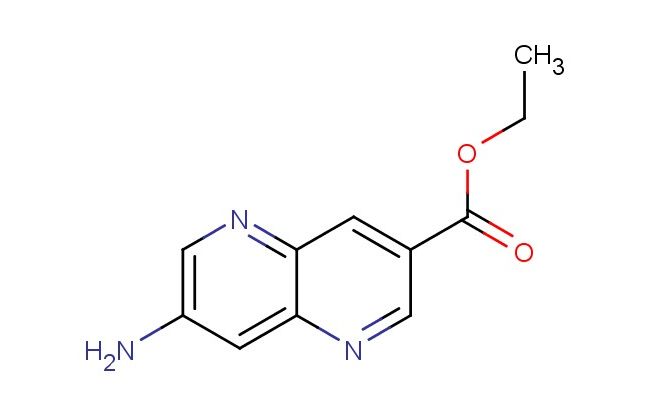ethyl 7-amino-1,5-naphthyridine-3-carboxylate
$360.00
CAS No.: 2089648-55-3
Catalog No.: 192094
Purity: 95%
MF: C11H11N3O2
MW: 217.228
Storage: 2-8 degree Celsius
SMILES: NC1=CN=C2C=C(C=NC2=C1)C(=O)OCC
Catalog No.: 192094
Purity: 95%
MF: C11H11N3O2
MW: 217.228
Storage: 2-8 degree Celsius
SMILES: NC1=CN=C2C=C(C=NC2=C1)C(=O)OCC
ethyl 7-amino-1,5-naphthyridine-3-carboxylate; CAS No.: 2089648-55-3; ethyl 7-amino-1,5-naphthyridine-3-carboxylate. PROPERTIES: Ethyl 7-amino-1,5-naphthyridine-3-carboxylate is a pale yellow crystalline powder with molecular formula C11H11N3O2. It has a molar mass of 213.23 g/mol and exhibits limited water solubility but good solubility in methanol and ethyl acetate. The compound melts between 150-153 C. Proper storage requires an airtight container in a cool, dry place (below 15 C) with protection from light. Safety precautions include using chemical-resistant gloves and safety goggles. The compound may cause eye irritation, so immediate rinsing with water is required upon contact. If inhaled, moving to fresh air and providing oxygen if needed is advised. The material should be stored away from heat and incompatible substances like strong acids. APPLICATIONS: In pharmaceutical research, ethyl 7-amino-1,5-naphthyridine-3-carboxylate serves as a building block for developing kinase inhibitors. Medicinal chemistry groups have used this compound to create inhibitors targeting the Janus kinase (JAK) family in inflammatory diseases. The amino group provides a functionality for forming hydrogen bonds with the kinase hinge region. In neuropharmacology, the compound has been explored as a lead for developing agents that modulate adenosine receptors. A study published in a medicinal chemistry journal demonstrated how derivatives of ethyl 7-amino-1,5-naphthyridine-3-carboxylate exhibited anxiolytic effects in rodent models of anxiety. Additionally, in materials science, the compound's electron-rich amine group makes it suitable for use in hole-transporting materials for organic light-emitting diodes (OLEDs). Researchers at a display technology company incorporated ethyl 7-amino-1,5-naphthyridine-3-carboxylate derivatives into OLED devices to improve charge injection efficiencies.
Reviews
Write Your Own Review





